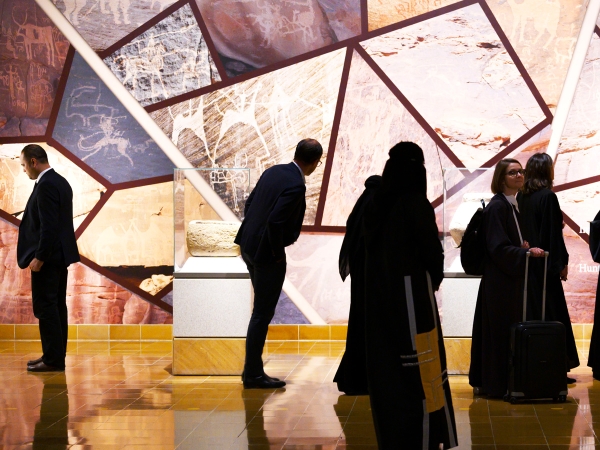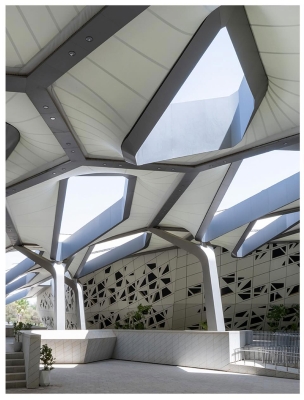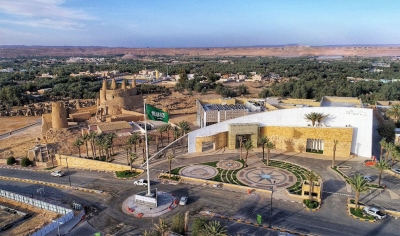

The Museum Sector Development Strategy is an organizational plan for the museum sector in the Kingdom of Saudi Arabia. It was launched by the Museums Commission, affiliated with the Ministry of Culture, on September 19, 2021. It aims to be a developmental mechanism that highlights the history and identity of the Kingdom, providing space for the sector to grow and elevate according to international standards.
The Museums Commission, through its strategy, seeks to bring about a vital change in the museum sector, develop the sector and its capabilities, enhance its programs and contents, empower and train its members, and create a supportive environment for museum development. This is to make museums cultural platforms for visitors from within and outside the Kingdom.
The Ministry of Culture supports the growth, development, and spread of Saudi museums across the Kingdom. It creates business opportunities to diversify their sources of income, diversifies their collections and specialties, attracts both local and international audiences, and provides educational programs that contribute to building a generation of museum specialists and enthusiasts.
Museum Sector Development Strategy Vision
The strategy has outlined the vision it will pursue, emphasizing the establishment of national museums as inspiring destinations and catalysts for cultural and social engagement for citizens, residents, and visitors. Its mission is to safeguard the national heritage from all over the world, promote it, and present it for study, education, and entertainment purposes, thereby positioning the Kingdom prominently on the global cultural stage with the highest quality standards. The strategic objectives encompassed twelve goals, including enriching institutions and collections and enhancing the value of existing heritage content, expanding the reach of museums by collaborating with high-quality institutions, and increasing museum visitation rates among both residents and tourists.
The objectives also include increasing the overall budget for the sector and improving spending efficiency. Additionally, they aim to establish distinguished and contemporary museums in major cities, and local museums in regions with rich and diverse heritage. Furthermore, the objectives include protecting collections, exhibiting them according to the highest standards, introducing educational and entertaining experiences, and attracting museum visitors. The strategy also seeks well-deserved recognition and appreciation both domestically and internationally. Moreover, it involves developing a qualified and experienced museum workforce, ensuring necessary financial support, stimulating third-sector participation, establishing partnerships to seize opportunities offered by the museum sector, enhancing its value, and issuing licenses and regulations to ensure comprehensive quality standards implementation.
Axes of the Museums Commission Strategy
The objectives of the Museums Commission strategy are focused on three axes. The first is in the cultural domain, through expanding the reach of museums and increasing their visitation rates, enhancing the value of cultural content, and boosting the budget of the sector while improving its efficiency. The second axis focuses on sector activities, involving the construction, care, and display of museums and their collections according to high standards. It also entails attracting visitors through the creation of engaging educational and entertainment experiences. The third axis focuses on empowering tools, which include talent development, issuing licenses, establishing regulatory frameworks, ensuring financial support, and fostering partnerships that provide additional value to museums.
The Museums Commission achieves its objectives by encouraging institutions, companies, and individuals to establish and develop museums. It organizes training courses and programs and accredits specialized entities to provide certifications in the field of museums. Additionally, it raises public awareness, highlights the importance and role of museums in showcasing the identity of the Kingdom, and represents it in local and international forums. The commission also seeks to organize conferences, events, and competitions related to the field, preserve tangible and intangible heritage, and display it in museums.
The commission strategy also aims to enhance communication with investors and stakeholders, support and empower workers in the sector, plan for the future organizational structure of the museum sector, and establish a unified trajectory for museums in the Kingdom, leveraging their vast cultural inventory.
Developing and creating museums in the Kingdom
The Museum Sector Development Strategy contributes to the enhancement of existing museums, such as al-Masmak Palace Museum and the National Museum. It is also working on two plans to establish museums across the Kingdom, from Ar'ar to Najran, and from Abha to Dammam, by 2024. Additionally, it involves the creation of several large and small museums in the coming years until 2030.
The museums established in the first phase include Tariq Abdulhakim Museum in Jeddah City and the Black Gold Museum in Riyadh City. The Ministry of Culture aims to allocate a site for the Saudi Museum of Contemporary Art in the JAX District in ad-Dir'iyah, for its temporary establishment until the opening of the grand museum. Medium-term plans include the opening of pioneering museums, such as the Digital Arts Museum, the Royal Arts Complex Museum, and the Museum of Prince Mohammed Bin Salman Global Center for Arabic Calligraphy.
Number of employees in the museum sector
The Museum Commission seeks to develop museums and enhance the human resources working within them. It aims to increase the employment of specialists in the museum sector, following the example of international museums where the number of employees can reach up to two thousand individuals. Additionally, it strives to achieve the targets of Saudi Vision 2030 by increasing the number of museums in the Kingdom, thereby creating numerous job opportunities.
Related quizzes
Related articles

